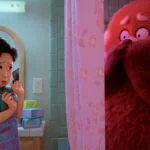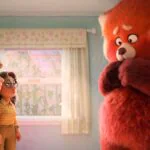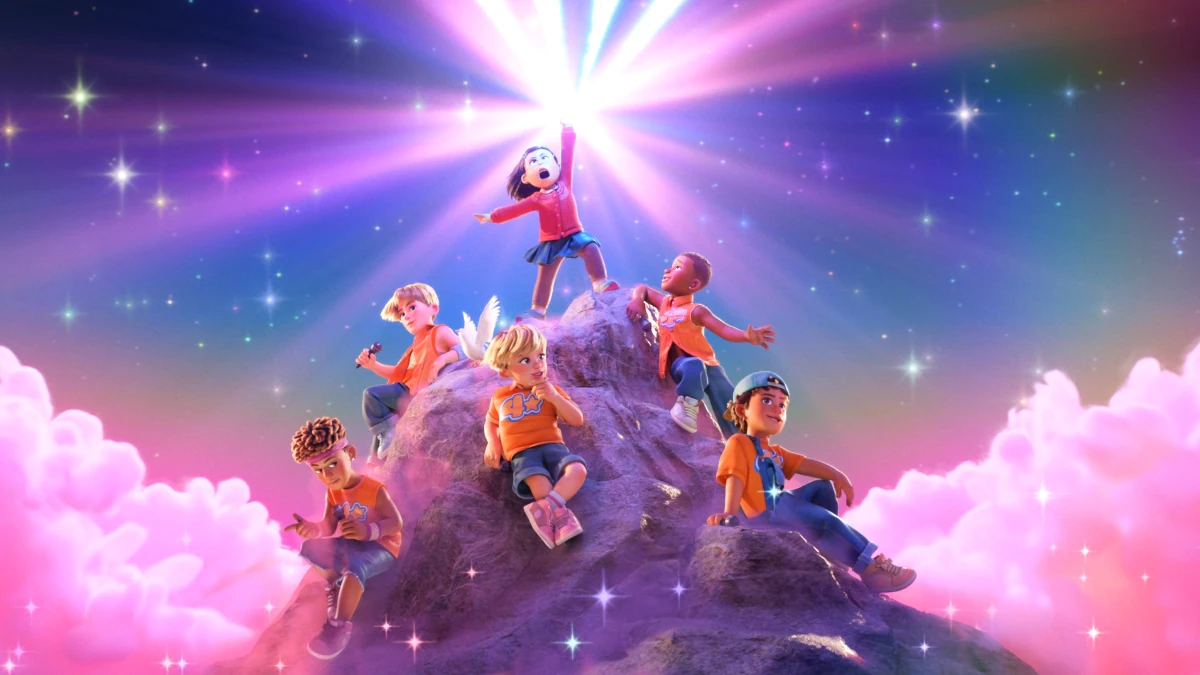Pixar’s “Turning Red” (which premieres exclusively on Disney+ March 11) is the story of Mei (Rosalie Chiang), a precocious 13-year-old Chinese girl growing up in Toronto, Canada. If being a tween wasn’t awkward enough, she finds herself transforming, when in a state of extreme emotional distress, into a giant red panda. Considering your tween-to-teen-years are nothing if not a series of highly emotional states, this causes some considerable complications. It’s a Pixar movie that looks – and feels – quite different from anything the studio has produced before.
spoke to director Domee Shi (making her feature directorial debut after her beloved short “Bao”) and producer Lindsey Collins (a longtime Pixar vet) about what it was like crafting this unique and irreverent film. They talked about how they cracked the “Asian tween fever dream” aesthetic, how working from home actually heightened the creative process and, of course, what it was like making Pixar’s horniest movie yet.

Domee, you described the film as having an “Asian tween fever dream” aesthetic. Can you talk about that affected the storytelling and how you developed?
Domee Shi: Yeah. It all just came from our main character Mei Lee and just wanting to design the world through her eyes. And she is this bubbly, excited, confident but super-dorky 13-year-old Asian kid in Canada, and what does that look like? What does her world look like? We drew a lot from our own backgrounds, of growing up loving anime, “Sailor Moon,” “Ranma ½” and just loving the super colorful soft pastels of those shows, and really feeling like that captures the spirit of Mei. And trying to like put that in the movie and really anytime Mei is feeling like an emotion like really, really strongly, like she sees her crush and she melts, or she’s like super embarrassed and put under the spotlight. We really wanted the audience to feel what Mei’s feeling.
And that’s another thing that I love about anime so much, is that there’s so much expressiveness in how the characters act. And they really exaggerate the lighting and the sets and everything frame to really make us feel what characters are feeling in that moment. That’s what we were inspired by in creating the look for “Turning Red.”

Lindsey, what was it like getting everybody on board, because it does feel and looks very different in the best possible way?
Lindsey Collins: Yeah. It does. And I think what was clear from the outset is that, there was a desire to be more stylized, be more, a little bit kind of away from the typical kind of look of our films. And that meant actually in camera, and in even the cutting pattern, in the way the character breaks the fourth wall, all the way to the character designs and the set designs. It didn’t feel as though Domee was just like, okay, I just want to do like a look that’s different. The whole aesthetic of the film that hit every single department was all holding hands and being like, Okay, we’re going to lean into this new way of kind of making this movie and having it look different and really feel different as you’re watching it.
The responsibility is across all the departments. There was a lot of communication that had to happen – a lot of exploration and a lot of looks tests that we needed to do in order to make sure that we were all on the same page. And then also we needed to obviously present that to Pete Docter and the rest of the studio, because it’s one thing to talk about stylization, it’s another thing to actually execute it and show it and get buy in. And Pete is known for wanting to push the boundaries of stuff. Anyway, the look of his films tend to be a little bit more stylized, so he was on board in theory for sure. And then it was more about showing it to him in reality and being like, Okay, we still good. And I think everybody bought in. Everybody had a real intention behind it and I think the studio was right on board.
Was there a period of trial and error?
Lindsey Collins: Right. Yes.
Domee Shi: Yeah. We had time earlier on in production to do looks tests to see what do those exaggerated anime expressions look like, how do we achieve them in 3D? What does it look like with the Asian teen fever dream?What does that look like for each department? It was just a lot of trial and error and then also showing Pete and sometimes he’ll reel us back if we go too far for him. Also for me eventually, I realized stylization should always come from a place of supporting the character and the emotion in the scene. And there is that point where it becomes almost too distracting or if you’re noticing the style over what’s actually happening on screen, then maybe that’s like a point to kind of reel back. It just took a lot of massaging and trial and error.

What’s interesting too, is there’s such grounded emotional territory underneath all of this. Was that always part of the design, where it was looking going to be these heightened visuals but feel very real? I would argue maybe the first truly horny Pixar movie. At least the horniest Pixar movie yet right?
Lindsey Collins: We back that up, yeah.
Domee Shi: I mean, from the very beginning we were going to be exploring magical puberty and all of what that means. And I know for me, like I felt like I wasn’t seeing a lot in media at the time, the experiences and emotions that I went through when I was that age. I’m really proud of the horny drawing spiral scene in the movie where Mei goes to her bed and goes crazy. I definitely had many of those moments in my life and many secret sketchbooks that I will burn if I ever find them again. I don’t know where I hid them in my parents’ house. And I just thought with this movie we could shed a light on this side of teen girls that you don’t really see that we are, or I was just as awkward and sweaty and lusty and excited as any of boy. And that’s something to celebrate and laugh at and cringe at.
There’s even a moment when Mei, as the raccoon, does this Tex Avery “a-oooga” at a cute boy who works at the convenience. You’ve never really seen that from a female character that I can think of. It’s pretty groundbreaking.
Domee Shi: Which is so funny to me because growing up me that’s all me and my friends, that’s just us being ourselves. I had my squad of girlfriends where all we would do was just draw pretty boys all the time and trade drawings with each other. And it’s just something that was just in my life that I thought was a really funny detail to share with the world.
The other thing that struck me was, we finally get a Pixar movie that acknowledges a title card. She interacts with the title card.
Domee Shi: Yeah. It basically just came from me growing up with a lot of family sitcoms and just being inspired by that, like “Clarissa Explains It All” or “Lizzie McGuire,” “Smart Guy,” “Sister, Sister.”
Lindsey Collins: She can keep going.
Domee Shi: Yeah, I could keep going. And it’s also the era too, our movie set in the early 2000s and I feel like a title card with the main character dancing around it feels very of that era of the 90s and early 2000s.
Lindsey Collins: We always like to like think about if Mei were like directing this because I feel like that whole intro is like, she just, I mean the fact that she does introduce herself, like she looks right at the camera, she tells you who she is. Even from the music, we thought about that in the score and then also in the title sequence, if this were Mei’s movie, how would she introduce herself and how would she play this whole opening sequence, because she’s the star of her own show. We really leaned into that idea for that whole opening title sequence.

Lindsey, could you talk about what the sort of hardest aspect of the production was?
Lindsey Collins: I think the hardest part honestly was, and I feel like it’s kind of predictable to say it, but it was true, is taking what has such a collaborative and vibrant environment that is Pixar and pulling the rug out from under that as we are heading into production on this film and everybody going home, and especially for Domee as a first time feature film director. All of a sudden she went from being surrounded by people walking around and getting an opportunity to ask questions or get reassured or have a moment to be like, you guys I’m freaking out about that shot that we just saw, that all just got immediately stripped away.
It initially was this fear of, can we actually do a collaboration – is this film going to suffer from a lack of collaboration being that we’re all at home. And I think in a weird way, and I don’t know, it’s like that weird moment of like, wow. First of all, the crew on the film and the leadership on the film, in addition to what this movie was about in some ways, it only lent itself to this pandemic in the sense that everybody’s families and mess were right behind them throughout this whole process, like kids were coming in. And I know I left my AirPods on as I was screaming at my teenage children and like I come back and Domee’s like, “Yeah, we all just heard that.” The moments of revealing, raw embarrassment and just exhaustion and failure, like the mess that was this last year and a half for all of us in a weird way lent itself totally to the theme of this film and there was just no hiding.
I mean, we were all out there and exposed in our messy lives and in each other’s lives by definition of Zoom. I do think while it was really hard, I think weirdly something came out of it that allowed everybody to drop any sense of barriers or hiding. It was just, everybody ended up being really, really vulnerable and real with each other throughout this whole thing. I don’t know, maybe it really helped with the making of it in some ways.
Can you talk a little bit about the all-female leadership team on this movie and what that experience was like for you?
Domee Shi: Yeah. It was so awesome in that, we already had this built-in shorthand of talking about issues that a 13-year-old girl would deal with. Like a lot of us have like have had that experience. And I know working with Julia Cho, our screenwriter. Story sessions would just be the two of us trading hilarious/traumatic stories about our own childhood and our relationships with our moms.
And it was great because like we always had this library of personal experiences to draw from and put in the movie and also working with Rona Liu our production designer… I worked with her on “Bao” and for “Turning Red” again, it’s that shorthand of like oh, I don’t need to explain what a Chinese household looks like or what an Asian kid’s room would look like in the early-2000s, because she had that reference in her head. I knew she could get those details right away. And that was really awesome and refreshing. It meant that we could work faster too. I loved it.
Lindsey Collins: It just had this common experience. And I mean that in the sense of, it just allowed us to be bolder I think, because we weren’t hesitating internally with any of the choices we were making. This is such a long process and we show it so many times, it’s so iterative that even the best of intentions can lead to it getting watered down because people are giving notes and you’re starting to second guess the choices you’re making as a filmmaker.
But when you are able to get internally, everybody’s on board and is like, yeah, yeah, yeah, no, that’s funny. Keep it in. No, I know it’s awkward, but it’s funny. Keep it in. By the time we shared it to the larger studio, we were confident in those decisions and in those choices such that it, I think, landed on the screen so close, if not better than where Domee started with it.
“Turning Red” is on Disney+ on March 11.


